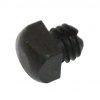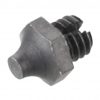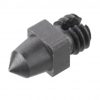Using horseshoe studs can improve your horse’s confidence, especially when competing on tricky going. However, making the wrong choice can have disastrous consequences due to potential for injury through twists, strains and other injuries. From understanding when to use studs, to choosing the right stud for the going, our expert guide contains all you need to know.
Why use horseshoe studs?
Obviously in order to use studs, your horse needs to be shod and for the horseshoes to be fitted with stud holes by your farrier. The most common type of shoe used on competition horses has a fuller (groove) that the nail heads sit inside and a concave inside edge, which act together to give the horse some grips without studs.
Before turning to studs, if your horse has a tendency to slip while on the roads, the most popular choice is to add tungsten nails to their shoes. This is a standard horseshoe nail with a tungsten carbide pin inserted into the head, which protrudes about 1mm and digs into the surface as the foot hits the floor.
Often referred to as ‘road nails’, they should always be used in pairs of feet, either fronts, backs or all four, to maintain the medial lateral balance of the foot and limb, and as far back as possible, to reduce shock to the hoof as it hits the ground.
In some horses this will be sufficient to provide the necessary grip to maintain their confidence, but if you are finding your horse still has a tendency to slip on certain going, then adding studs is the obvious next step.
However, studs should not be used to make up for poor riding or a lack of training in horse or rider. It’s important that riders invest sufficient time in ensuring that their horses are used to working on different surfaces to reduce the likelihood of slipping.
As showjumper Holly Smith says: “Some people spend too much time blaming their studs, rather than worrying about how they are riding.”
It’s also important to remember a little slipping of the hoof when it lands on a surface is a natural and important part of the normal function of the forelimbs in absorbing concussion. Studs prevent this from happening, leading to increased forces going up the leg so should only be used when absolutely necessary.
How many studs?
If you feel that your horse would benefit from having horseshoe studs, you need to decide whether they need them in both front and back shoes, as well as how many in each shoe and which types of studs to use.
Traditionally many riders only used studs in the outside of the shoe and there is a school of thought that believes a single stud on the outside of the hoof reduces strain on the leg’s structures when making a tight turn.
However, most farriers now recommend using a pair of studs (one in each side of the shoe) in either both rear shoes or all four shoes in order to maintain medial lateral foot balance. Studs should be of similar size across a pair of feet and slightly larger studs can be used in rear shoes compared to in front.
In all cases the smallest possible studs should be chosen. Prolonged use of big studs on firm ground can produce vertical fractures in the hoof wall directly above the studs, so this should be avoided.
Riders should avoid using pointed studs on the inside of the hoof due to the potential for strike damage to the opposite leg. For this reason it is sensible for horses with studs to wear boots for protection. A stud girth is also a wise precaution if your horse is wearing studs in their front shoes.
What’s in your stud kit?
Your stud kit should contain a variety of different shaped studs to suit your horse’s needs, a stud tap (to clean the thread in the stud hole before use), a spanner (the adjustable ones are ideal) and stud plugs plus a spare horseshoe nail.

Liveryman Stud Kit
This kit contains a selection of 16 assorted studs (standard, pointed, road and dome), plus a tap and spanner.
In addition you may find it useful to invest in a magnetic metal bowl, which will keep your studs exactly where you need them, even if the bowl is knocked over, and is also useful for finding studs when dropped on the grass. There are also magnetic wristbands available that do a similar job, holding the studs for you until you need to use them.

Magnetic bowl
This magnetic stainless steel bowl measures 15cm across and has a soft, non-marking base.
Stud holes should always be plugged when not in use, to prevent dirt and stones clogging them up. Designed to keep the empty hole clean, ready-made plugs (or sleepers) come in shaped cotton wool, metal, rubber or plastic, although many riders make their own with a piece of cotton wool covered in petroleum jelly, which is an inexpensive and effective alternative.

LeMieux Stud Plugs
These reusable rubber stud plugs have a small hole in the centre that allows you to use a horseshoe nail for easy removal. Pack includes six sets of 10 plugs.
It also makes sense to clean the stud holes out the day before a competition, before replugging them, rather than attempting it at the show, when the horse may be impatient to get on with the job. There are few things more panic-inducing than arriving at a show with limited time to find you have a small stone wedged in a stud hole!
The studs should be cleaned after use and carefully stored to avoid the thread deteriorating, which can render them useless, and at worst necessitate a visit from the farrier if one cross-threads and gets stuck in the hole.
Which studs to use?
Studs are typically most useful when the ground has been firm and then it has rained, causing the top surface to be slippery, but there is a wide range of studs on the market, so it’s important to always choose the appropriate stud to suit the conditions. Furthermore, take special care not to use over-large studs on ponies and smaller horses. Some of the bigger studs are designed only to be worn on the hind shoes, and on larger horses. A smaller horse will be able to grip with a smaller stud.
Supastuds studs are designed to be “self-cleaning”, meaning you don’t have to retap the hole each time. Their range covers the different types and shapes of studs to help horses cope with whatever going is underfoot.
- Road stud – a small flattish stud (8-9mm approx) with a tiny point: for grip on slippery tarmac or hard ground. These are extra durable for the rigours of roadwork.
- Conical stud – a versatile cone-shaped stud designed for a variety of conditions whenever you need more grip, for example turning and jumping. There are different sizes: small, medium and large, which denote the length, to be used according to the conditions. Small (approx 16mm), for use on good grass going, while large (approx 25mm) is designed to help the horse cope with sharp turns on greasy going. Conical studs are the most popular all-round stud
- Dome stud – an oval shape with a pointed dome top. This is a compact chunky stud (18mm) suitable for soft conditions. There is also a large or maxi dome (2cm), designed for larger horses (and hind shoes) on soft going
- Bullet stud – this is a smallish block-shaped stud (14mm), which gives extra grip in normal – good-soft – conditions and often used for polo. It’s quite chunky for hard ground. For those on larger horses needing extra grip on deep going, these are available in up to 2cm long
- Polo stud – these are a blunt cubic stud for sharp turns and braking on generally good going. They come in a variety of sizes from around 12mm down to 7mm depending on the size of pony and grip required
- Sharp stud – another small stud (15mm) but with a sharp point, designed for hard ground. These are available in slightly smaller (1cm) – in between a road stud and sharp stud
- Arena stud – a large square stud (20mm) tapering to a sharp point, designed for muddy conditions or on an artificial surface.
- Dressage studs – available in small (14mm) and medium. Despite the name, these are suitable for all disciplines, giving extra grip on firm going.
While most riders like to emulate top riders or trainers, it’s important that you take time to discover which studs are right for you and your horse. Trying studs out while you are schooling, where you can stop and make changes if necessary, is advisable rather than trying a new set-up of studs at a competition.

Supastud Original Road Stud
For use on the road and on hard ground, this 8mm stud (excluding threaded section) is extra hardened to stand up to the rigours of road work.

Supastud Medium Conical Stud
Ideal for slippery grass or greasy surface conditions, this 18mm stud (excluding threaded section) is perfect for when dew or a sudden shower is added to hard ground. Can be used in hind shoes in conjunction with small conical studs in front.

Supastud Dome Stud
This soft ground stud is oval shape for good grip. It is 18mm (excluding threaded section), which makes it a chunky stud ideal for soft, muddy conditions.

Supastud Bullet Stud
This utility stud is useful in a range of good to soft conditions when the ground is not too hard or slippery. It’s 14mm (excluding threaded section) and can be used in front or behind on any size of horse.

Supastud Arena Stud
Designed specifically for use on an artificial surface but is also good for muddy conditions. This large stud is 20mm (excluding threaded section) with a 12mm square base tapering gradually to a point.
Expert tips for using horseshoe studs
- Use blunt (not pointed) studs on the inside branches of the shoe
- Use the smallest studs that will do the job
- If you need studs in all four shoes, use smaller studs in front than behind
- Choose studs according to conditions, horse type, movement and type of competition
- Typically the softer the ground, the larger the studs needed
- Stud up just before you compete and remove them immediately after you are finished
- Don’t load or travel horses in studs (unless the studs are nearly flat and designed to be worn during travelling)
- Avoid leading or riding horses on hard surfaces in studs
- Clean and retap stud holes the day before you are planning to use them
- Keep stud holes plugged with an appropriate material when not in use
- Practise putting studs at home before trying at a show
- Most farriers are a useful source of advice, so do ask their opinion
- Clean studs after use and to avoid rust, wrap them in a lightly oiled cloth
- Store your stud kit together so you don’t lose anything
You may also be interested to read…

When should you use studs on your horse?

11 horseshoe gifts perfect for a wedding

Myth, magic and mystery: 12 interesting facts you might not know about horseshoes

Subscribe to Horse & Hound magazine today – and enjoy unlimited website access all year round
Horse & Hound magazine, out every Thursday, is packed with all the latest news and reports, as well as interviews, specials, nostalgia, vet and training advice. Find how you can enjoy the magazine delivered to your door every week, plus options to upgrade your subscription to access our online service that brings you breaking news and reports as well as other benefits.








